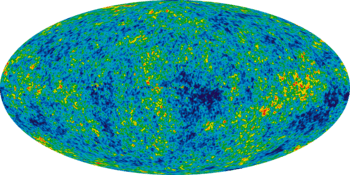Atacama B-Mode Search
|
The Atacama B-Mode Search Telescope on top of its shipping container. | |
| Location(s) | Atacama Desert |
|---|---|
| Coordinates | 22°58′S 67°47′W / 22.96°S 67.79°WCoordinates: 22°58′S 67°47′W / 22.96°S 67.79°W |
| Altitude | 5,200 m (17,100 ft) |
| Wavelength | 2±0.1 millimetre |
| Telescope style | radio telescope |
| Website |
www |
The Atacama B-Mode Search (ABS) is an ongoing experiment to test the theory of cosmic inflation and distinguish between inflationary models of the very early universe by making precise measurements of the polarization of the Cosmic Microwave Background (CMB). ABS is located at a high-altitude site in the Atacama Desert of Chile as part of the Parque Astronómico de Atacama.[1] ABS began observations in February 2012, and is currently in its third season of observations.
Instrument
The ABS telescope images the sky at a frequency of 145 GHz (2 mm wavelength), in the microwave region of the electromagnetic spectrum, where the CMB emission is at its maximum. It is sensitive to both the intensity and polarization of the CMB. The CMB is expected to be weakly polarized, and the ABS instrument is designed to measure this very faint signal. The camera consists of 240 polarization-sensitive pixels, with two transition-edge-sensor (TES) bolometers per pixel. This TES array is cooled to a temperature of 0.3 Kelvin to reduce thermal noise in the detectors.[2] The optics consist of two 60-cm mirrors that are kept at a temperature of 4 K.
The high-altitude site, at 5200 meters above sea level, in a very dry climate reduces loading from the atmosphere, since water vapor has strong emission at these frequencies. Nearby sites have been chosen by other observatories for the same reason, including CBI, ASTE, Nanten, APEX, ALMA, ACT, and POLARBEAR.
The ABS experiment was designed for rapid deployment by being built in North America into a standard shipping container. Upon arrival in Chile, the telescope was raised out of a special hatch in the roof of the shipping container for observations. Compared to other similar experiments, ABS is unique in using an ambient-temperature half-wave plate to quickly modulate incoming polarization.[3] This allows the instrument to "lock in" to the polarized signal of interest and reject the atmosphere, which is largely unpolarized.[4]
Science goals
The observations made by ABS will test the theory of inflation, the leading theory of the very early universe;[5] however, observational evidence for inflation is still inconclusive. Inflationary models generically predict that a gravitational-wave background (GWB) would have been produced along with the density perturbations that seed large-scale structure formation. Such an inflationary GWB would leave an imprint on both the temperature and polarization of the CMB. In particular it would leave a very distinctive and unique pattern of polarization, called a B-mode pattern, in the CMB polarization. A measurement of B-mode polarization in the CMB would be important confirmation of inflation and would provide a rare glimpse into physics at ultra-high energies.[6][7]
See also
| Wikimedia Commons has media related to Atacama B-Mode Search. |
References
- ↑ "Astronomy, Technology, Industry: Roadmap for the Fostering of Technology Development and Innovation in the Field of Astronomy in Chile" (PDF). CONICYT Ministry of Education, Government of Chile. Retrieved 2014-02-10.
- ↑ Essinger-Hileman, T.; et al. (2010). "The Atacama B-Mode Search: CMB Polarimetry with Transition-Edge-Sensor Bolometers". Proceedings of the Thirteenth International Conference on Low-Temperature Detectors. 1185. arXiv:1008.3915
 . Bibcode:2010arXiv1008.3915E.
. Bibcode:2010arXiv1008.3915E. - ↑ Kusaka, A.; et al. (2014). "Modulation of cosmic microwave background polarization with a warm rapidly rotating half-wave plate on the Atacama B-Mode Search instrument". Review of Scientific Instruments. 85 (2): 024501. Bibcode:2014RScI...85b4501K. doi:10.1063/1.4862058. PMID 24593374.
- ↑ "ABS Experiment". Retrieved 2014-07-31.
- ↑ Linde, A. (2014). "Inflationary Cosmology after Planck 2013". arXiv:1402.0526
 [hep-th].
[hep-th]. - ↑ Boyle, Latham A.; Steinhardt, PJ; Turok, N (2006). "Inflationary predictions for scalar and tensor fluctuations reconsidered". Physical Review Letters. 96 (11): 111301. arXiv:astro-ph/0507455
 . Bibcode:2006PhRvL..96k1301B. doi:10.1103/PhysRevLett.96.111301. PMID 16605810.
. Bibcode:2006PhRvL..96k1301B. doi:10.1103/PhysRevLett.96.111301. PMID 16605810. - ↑ Tegmark, Max (2005). "What does inflation really predict?". JCAP. 0504 (4): 001. arXiv:astro-ph/0410281
 . Bibcode:2005JCAP...04..001T. doi:10.1088/1475-7516/2005/04/001.
. Bibcode:2005JCAP...04..001T. doi:10.1088/1475-7516/2005/04/001.
